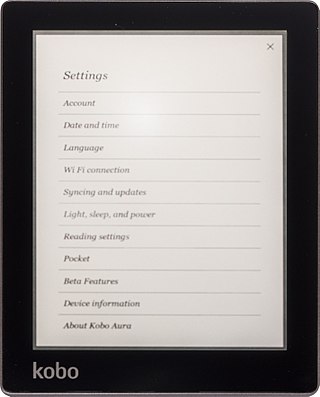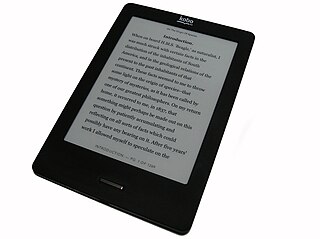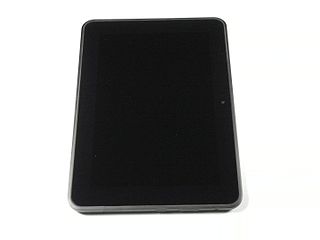
The Sony Reader was a line of e-book readers manufactured by Sony, who produced the first commercial E Ink e-reader with the Sony Librie in 2004. It used an electronic paper display developed by E Ink Corporation, was viewable in direct sunlight, required no power to maintain a static image, and was usable in portrait or landscape orientation.

An e-reader, also called an e-book reader or e-book device, is a mobile electronic device that is designed primarily for the purpose of reading digital e-books and periodicals.
Amazon Kindle is a series of e-readers designed and marketed by Amazon. Amazon Kindle devices enable users to browse, buy, download, and read e-books, newspapers, magazines and other digital media via wireless networking to the Kindle Store. The hardware platform, which Amazon subsidiary Lab126 developed, began as a single device in 2007. Currently, it comprises a range of devices, including e-readers with E Ink electronic paper displays and Kindle applications on all major computing platforms. All Kindle devices integrate with Windows and macOS file systems and Kindle Store content and, as of March 2018, the store had over six million e-books available in the United States.

An ebook, also known as an e-book or eBook, is a book publication made available in digital form, consisting of text, images, or both, readable on the flat-panel display of computers or other electronic devices. Although sometimes defined as "an electronic version of a printed book", some e-books exist without a printed equivalent. E-books can be read on dedicated e-reader devices, but also on any computer device that features a controllable viewing screen, including desktop computers, laptops, tablets and smartphones.

The Kobo eReader is an e-reader produced by Toronto-based Kobo Inc. The company's name is an anagram of "book". The original version was released in May 2010 and was marketed as a minimalist alternative to the more expensive e-book readers available at the time. Like most e-readers, the Kobo uses an electronic ink screen. The Arc tablet series, released between 2011 and 2013, was based on LCD technology instead.
Rakuten Kobo Inc., or simply Kobo, is a Canadian company that sells ebooks, audiobooks, ereaders and tablet computers. It is headquartered in Toronto, Ontario, and is a subsidiary of the Japanese ecommerce conglomerate Rakuten. The name Kobo is an anagram of book.

Cruz is a line of Android-based e-book readers and tablet computers by Velocity Micro, a privately held computer manufacturer located in Richmond, Virginia that specializes in custom high-end computers.

The Kobo Touch is the third generation of the Kobo e-reader device designed by Kobo Inc. It was revealed on 23 May 2011 and was released in the U.S. on 10 June 2011 at a price of $129.99.

The Barnes & Noble Nook is a brand of e-readers developed by American book retailer Barnes & Noble, based on the Android platform. The original device was announced in the U.S. in October 2009, and was released the next month. The original Nook had a six-inch E-paper display and a separate, smaller color touchscreen that serves as the primary input device and was capable of Wi-Fi and AT&T 3G wireless connectivity. The original Nook was followed in November 2010 by a color LCD device called the Nook Color, in June 2011 by the Nook Simple Touch, and in November 2011 and February 2012 by the Nook Tablet. On April 30, 2012, Barnes & Noble entered into a partnership with Microsoft that spun off the Nook and college businesses into a subsidiary. On August 28, 2012, Barnes and Noble announced partnerships with retailers in the UK, which began offering the Nook digital products in October 2012. In December 2014, B&N purchased Microsoft's Nook shares, ending the partnership.

The Amazon Fire, formerly called the Kindle Fire, is a line of tablet computers developed by Amazon. Built with Quanta Computer, the Kindle Fire was first released in November 2011, featuring a color 7-inch multi-touch display with IPS technology and running on Fire OS, an Android-based operating system. The Kindle Fire HD followed in September 2012, and the Kindle Fire HDX in September 2013. In September 2014, when the fourth generation was introduced, the name "Kindle" was dropped. In later generations, the Fire tablet is also able to convert into a Smart speaker turning on the "Show Mode" options, which the primary interaction will be by voice command through Alexa.
The Nook Tablet is a tablet e-reader/media player that was produced and marketed by Barnes & Noble. It followed the Nook Color and was intended to compete with both e-book readers and tablet computers.

The Kobo Glo is the fourth generation of Kobo eReader devices designed and marketed by Kobo Inc. It was revealed on 6 September 2012 and arrived at retail 14 October 2012 with a price of $129.99 USD/CAD. It is the successor to the popular Kobo Touch was introduced alongside the Kobo Mini and Kobo Arc. The Glo was succeeded in 2015 by the higher-resolution Glo HD, with 4GB built-in storage but no microSD removable storage.

The Fire HD, also known as Kindle Fire HD, is a member of the Amazon Fire family of tablet computers. Fire HD refers to Amazon Fire family tablets with HD resolution. The ten generation Fire HD subfamily consists of: 7" and 8.9", 7", 6" and 7", 8" and 10.1", 8", 8" and 10.1", 8", 10.1", 8", and 10.1". These devices run the Fire OS operating system.

The iPad Mini is a line of mini tablet computers designed, developed, and marketed by Apple Inc. It is a sub-series of the iPad line of tablets, with screen sizes of 7.9 inches and 8.3 inches. The first-generation iPad Mini was announced on October 23, 2012, and was released on November 2, 2012, in nearly all of Apple's markets. It featured similar internal specifications to the iPad 2, including its display resolution.

The iPad is a tablet computer produced and marketed by Apple Inc. Compared to its predecessor, the third-generation iPad, the fourth-generation iPad maintained the Retina Display but featured new and upgraded components such as the Apple A6X chip and the Lightning connector, which was introduced on September 12, 2012. It shipped with iOS 6, which provides a platform for audio-visual media, including electronic books, periodicals, films, music, computer games, presentations and web content. Like the third-generation iPad it replaced, it was supported by five major iOS releases, in this case iOS 6, 7, 8, 9, and 10. iOS 11, which was released on September 19, 2017, does not support the fourth-generation iPad as that update does not support 32-bit devices and apps.

The second-generation Nexus 7, also commonly referred to as the Nexus 7 (2013), is a mini tablet computer co-developed by Google and Asus that runs the Android operating system. It is the second of three tablets in the Google Nexus tablet series, the Nexus family including both phones and tablets running essentially stock Android which were originally marketed for developer testing but later marketed by Google to consumers as well, all of which were built by various original equipment manufacturer partners. Following the success of the original Nexus 7, this second generation of the device was released on July 26, 2013, four days earlier than the originally scheduled date due to early releases from various retailers. The tablet was the first device to ship with Android 4.3.
The Kobo Aura HD is a limited-edition Kobo eReader device designed and marketed by Kobo Inc. It was revealed 15 April 2013 and allowed for preorders the next day at a price of 169.99 USD/CAD. It arrived in stores in Canada and the United Kingdom on 25 April 2013. The marketing slogan of the Kobo Aura HD was "The eReader, reimagined." In October 2014 the Kobo Aura H2O was launched, it has a similar screen resolution to the Kobo Aura HD but has a waterproof coating. Kobo's CEO announced in March 2015 that the Kobo Aura HD was officially discontinued.

The Kobo Aura is the fifth generation of E-book readers designed and marketed by Kobo Inc. It was revealed 27 August 2013 at Kobo's Beyond the Book Event in New York City, along with three new Kobo Arc devices. Available for pre-order the same day, it cost $149.99 USD/CAD.

The first-generation iPad Mini is a mini tablet computer designed, developed, and marketed by Apple Inc. It was announced on October 23, 2012, as the fourth major product in the iPad line and the first of the iPad Mini line, which features a reduced screen size of 7.9 inches (20 cm), in contrast to the standard 9.7 inches (25 cm). It features similar internal specifications to the iPad 2, including its display resolution.

The fifth generation iPod Touch was unveiled at Apple's media event alongside the iPhone 5 on September 12, 2012, and was released on October 11, 2012. A mobile device designed and marketed by Apple Inc. with a touchscreen-based user interface, it succeeded the 4th-generation iPod Touch. It is compatible with up to iOS 9.3.5, which was released on August 25, 2016.















